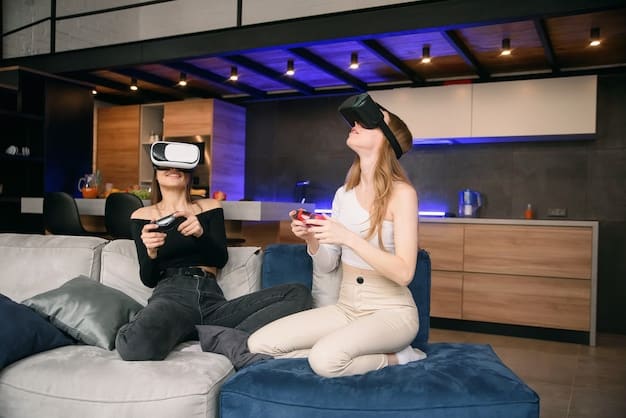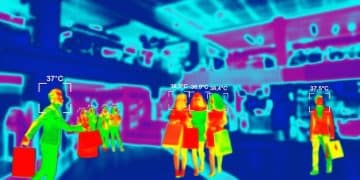E-commerce AR/VR Investments: Is It a Worthwhile Long-Term Bet?

E-commerce AR/VR investments present a compelling long-term opportunity, enabling immersive shopping experiences that can boost customer engagement, brand loyalty, and ultimately, sales, though they require strategic planning and a considered approach to implementation.
The rise of augmented reality (AR) and virtual reality (VR) is transforming numerous industries, and e-commerce is no exception. E-commerce AR/VR investments are being considered by many as a way to bring shopping experiences to a new and immersive level. But are these investments a solid long-term strategy, or just a passing fad?
Understanding the Evolving Landscape of E-commerce
The e-commerce industry has undergone significant changes over the past few decades. From the early days of simple online storefronts to the sophisticated, personalized experiences consumers expect today, innovation has been the key driver. Augmented and virtual reality technologies are the next frontier, promising to merge the digital and physical worlds in ways that were once considered science fiction.
As consumers become more digitally savvy, their expectations for online shopping experiences increase. They seek more than just product listings; they want detailed product information, interactive experiences, and the ability to visualize products in their own environment. This demand has fueled the growth of AR/VR technologies in e-commerce, as retailers explore ways to enhance the customer journey.
The Promise of AR/VR in E-commerce
AR and VR offer distinct but complementary benefits to e-commerce. Augmented reality overlays digital information onto the real world, allowing customers to see how a product would look in their home before making a purchase. Virtual reality, on the other hand, creates a fully immersive digital environment, transporting customers to a virtual store or showroom.
Both technologies have the potential to address some of the key challenges facing e-commerce retailers, such as high return rates due to inaccurate product visualization and a lack of engagement with online stores. By providing more realistic and interactive shopping experiences, AR/VR can increase customer confidence, reduce returns, and boost sales.
- Enhanced Product Visualization: AR allows customers to virtually “try on” clothes or “place” furniture in their homes.
- Increased Engagement: VR creates immersive shopping experiences that capture and hold customer attention.
- Reduced Returns: By providing a more accurate representation of products, AR/VR can minimize discrepancies between expectations and reality.
- Improved Brand Loyalty: Memorable AR/VR experiences can foster a stronger connection between customers and brands.
The integration of AR and VR in e-commerce represents a significant step towards creating a more engaging, personalized, and ultimately successful online shopping experience. These immersive technologies address critical pain points for both retailers and consumers, making them an attractive area for investment and innovation.
Analyzing the Investment Potential of AR/VR in E-commerce
Investing in AR/VR for e-commerce is not just about adopting new technologies; it’s about strategically enhancing the shopping experience to drive tangible business results. A thorough analysis of the investment potential involves understanding the current market trends, the potential return on investment (ROI), and the associated risks.
The AR/VR market is projected to experience substantial growth in the coming years, driven by increasing adoption in various industries, including e-commerce. As the technologies become more accessible and affordable, more retailers will explore their potential to improve customer engagement and boost sales.

Calculating the ROI of AR/VR Investments
Determining the ROI of AR/VR investments requires a comprehensive assessment of both the costs and benefits. On the cost side, retailers need to consider the initial investment in hardware and software, as well as the ongoing costs of maintenance, updates, and content creation. On the benefit side, potential gains include increased sales, reduced returns, improved customer satisfaction, and enhanced brand perception.
To accurately calculate the ROI, retailers should track key metrics such as conversion rates, average order value, return rates, and customer lifetime value. By comparing these metrics before and after the implementation of AR/VR technologies, they can gain a clear understanding of the impact on their bottom line.
- Increased Conversion Rates: AR/VR can encourage more customers to make a purchase by providing a more realistic and engaging shopping experience.
- Reduced Return Rates: Accurate product visualization can minimize discrepancies between customer expectations and the reality of the product.
- Higher Customer Lifetime Value: Satisfied customers are more likely to become repeat buyers and brand advocates.
The potential ROI of AR/VR investments in e-commerce is significant. Retailers that strategically implement these technologies can see substantial improvements in key business metrics, leading to increased profitability and long-term success.
Identifying Key Players and Success Stories
Several companies have already begun to successfully integrate AR/VR into their e-commerce strategies, demonstrating the potential of these technologies to transform the shopping experience. Examining these key players and their success stories can provide valuable insights for retailers considering similar investments.
From furniture retailers using AR to let customers visualize products in their homes to fashion brands creating virtual try-on experiences, the applications of AR/VR in e-commerce are diverse and innovative. These early adopters are paving the way for broader adoption, setting new standards for online shopping experiences.
Examples of Successful AR/VR Implementations
One notable example is IKEA, which has developed an AR app that allows customers to virtually place furniture in their homes. This app enables customers to see how a piece of furniture will look and fit in their space before making a purchase, reducing the risk of returns and increasing customer satisfaction.
Another success story is Sephora, which has implemented a virtual try-on feature that allows customers to experiment with different makeup products using their smartphone cameras. This feature not only enhances the shopping experience but also provides valuable data on customer preferences and behavior.
- IKEA: AR app for visualizing furniture in real homes.
- Sephora: Virtual try-on feature for makeup products.
- Warby Parker: Virtual try-on for glasses.
These examples highlight the transformative potential of AR/VR in e-commerce. By providing more realistic, interactive, and personalized shopping experiences, these companies are setting new standards for online retail and driving customer engagement.
These companies’ experiences provide valuable lessons for retailers considering AR/VR investments: understanding the target audience, focusing on solving specific customer pain points, and continuously iterating on the technology based on user feedback.
Addressing the Challenges and Risks of AR/VR Investments
While the potential benefits of AR/VR in e-commerce are significant, it’s important to acknowledge the challenges and risks associated with these investments. From technological hurdles to customer adoption concerns, retailers need to carefully consider these factors before committing to AR/VR initiatives.
One of the primary challenges is the cost of developing and maintaining AR/VR applications. These technologies require specialized expertise and sophisticated software, which can be expensive. Additionally, retailers need to ensure that their AR/VR experiences are compatible with a wide range of devices and platforms, adding to the complexity and cost.

Overcoming Technical and Adoption Barriers
Another challenge is ensuring that AR/VR experiences are user-friendly and accessible to a broad audience. Many customers may be unfamiliar with these technologies and may require guidance on how to use them effectively. Retailers need to invest in training and support to ensure that customers can easily access and enjoy AR/VR experiences.
Additionally, retailers need to address concerns about privacy and security. AR/VR applications often require access to sensitive customer data, such as location information and personal preferences. Retailers need to implement robust security measures to protect this data and ensure that customers feel confident using AR/VR technologies.
- High Development Costs: Specialized expertise and software can be expensive.
- Technology Limitations: Ensuring compatibility across devices and platforms.
- Customer Adoption Barriers: Addressing unfamiliarity and providing user-friendly experiences.
- Privacy and Security Concerns: Protecting sensitive customer data.
Addressing these challenges requires a strategic and proactive approach. Retailers need to carefully plan their AR/VR initiatives, invest in the necessary expertise and infrastructure, and prioritize customer experience and data security.
Formulating a Strategic Approach to AR/VR Implementation
Successfully implementing AR/VR in e-commerce requires a well-defined strategy that aligns with the overall business goals and addresses specific customer needs. This involves identifying the right use cases, selecting the appropriate technologies, and continuously monitoring and optimizing the results.
One of the first steps is to conduct a thorough assessment of the target audience. Retailers need to understand their customers’ preferences, behaviors, and technological capabilities in order to develop AR/VR experiences that resonate with them.
Key Considerations for Strategic Implementation
Another important consideration is the selection of the right AR/VR technologies. There are a variety of different platforms and tools available, each with its own strengths and weaknesses. Retailers need to carefully evaluate these options and choose the technologies that best fit their needs and budget.
Once the AR/VR experiences have been implemented, retailers need to continuously monitor and optimize their performance. This involves tracking key metrics such as engagement rates, conversion rates, and customer satisfaction scores. By analyzing this data, retailers can identify areas for improvement and refine their AR/VR strategies over time.
- Audience Analysis: Understand customer preferences and technological capabilities.
- Technology Selection: Choose the right AR/VR platforms and tools.
- Performance Monitoring: Track key metrics and identify areas for improvement.
- Continuous Optimization: Refine AR/VR strategies over time.
By formulating a strategic approach to AR/VR implementation, retailers can maximize the benefits of these technologies and create truly transformative shopping experiences for their customers.
The Future of E-commerce: Predictions and Trends
The future of e-commerce is inextricably linked to the continued advancement and adoption of AR/VR technologies. As these technologies become more sophisticated and accessible, they will play an increasingly important role in shaping the online shopping experience.
One key trend is the convergence of the digital and physical worlds. AR/VR technologies are blurring the lines between online and offline retail, allowing customers to seamlessly transition between the two. For example, customers may use AR to visualize products in their homes before visiting a physical store to make a purchase. Such seamless integrations are becoming increasingly common.
Emerging Trends in AR/VR E-commerce
Another trend is the rise of personalized shopping experiences. AR/VR technologies are enabling retailers to create highly customized shopping experiences that cater to individual customer preferences. This includes personalized product recommendations, virtual try-on features, and interactive product demonstrations.
Finally, the potential benefits of AR/VR stretch to logistics, as well. Efficiency can be improved in warehousing through AR navigation and item identification. The final steps to consumer fulfillment are also impacted, giving updates and allowing users to visualize package arrival via AR mapping. This enhances post-purchase engagement, increasing satisfaction.
- Convergence of Digital and Physical Worlds: Blurring the lines between online and offline retail.
- Personalized Shopping Experiences: Tailoring shopping experiences to individual preferences.
- Enhanced Logistics: Optimizing warehouse operations.
As AR/VR technologies continue to evolve, they will revolutionize the e-commerce industry, creating new opportunities for retailers to engage with customers, drive sales, and build brand loyalty.
| Key Point | Brief Description |
|---|---|
| 🚀 Enhanced Engagement | AR/VR offers immersive experiences, boosting customer interaction. |
| 🛍️ Reduced Returns | Accurate visualization minimizes discrepancies, lowering return rates. |
| 📈 ROI Potential | Strategic AR/VR implementation drives profitability. |
| 🎯 Personalized Experiences | AR/VR enables tailored shopping based on customer preferences. |
FAQ
▼
AR enhances product visualization, allowing customers to see how items fit in their surroundings before buying. This leads to increased confidence, fewer returns, and a more satisfying shopping experience, ultimately boosting customer loyalty.
▼
VR offers immersive experiences, creating virtual showrooms or stores that capture customer attention. This heightened engagement promotes longer browsing times, greater brand recall, and ultimately, a stronger connection between customers and products.
▼
High development costs, technology limitations, and ensuring user-friendliness are key hurdles. Retailers also face privacy and security considerations, requiring robust measures for safeguarding customer data in these innovative environments.
▼
Furniture, fashion, and cosmetics are among the top beneficiaries. AR allows virtual placement or try-ons, enhancing the buying process. VR provides engaging brand experiences, revolutionizing how customers interact with products and services.
▼
AR/VR represents a growing opportunity for retailers looking to differentiate themselves. The integration of logistics, personalized shopping, and mixed reality interfaces is forecasted to greatly change both customer and retailer experiences.
Conclusion
In conclusion, e-commerce AR/VR investments present a promising long-term bet for retailers willing to embrace innovation and adapt to evolving consumer expectations. By strategically implementing these technologies, retailers can enhance the shopping experience, drive sales, and build stronger relationships with their customers, ensuring long-term success in an increasingly competitive market.





